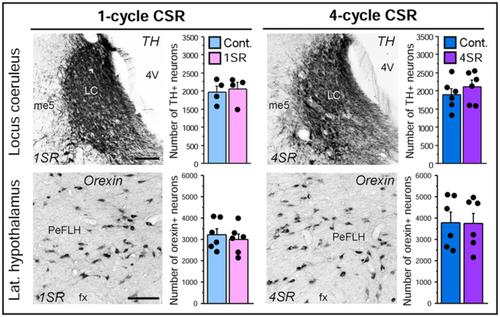当前位置:
X-MOL 学术
›
Eur. J. Neurosci.
›
论文详情
Our official English website, www.x-mol.net, welcomes your
feedback! (Note: you will need to create a separate account there.)
No loss of orexin/hypocretin, melanin-concentrating hormone or locus coeruleus noradrenergic neurons in a rat model of chronic sleep restriction
European Journal of Neuroscience ( IF 2.7 ) Pub Date : 2021-08-05 , DOI: 10.1111/ejn.15412 Samuel Deurveilher 1 , Michael Antonchuk 1 , Brock St. C. Saumure 1 , Andrew Baldin 1 , Kazue Semba 1, 2, 3
European Journal of Neuroscience ( IF 2.7 ) Pub Date : 2021-08-05 , DOI: 10.1111/ejn.15412 Samuel Deurveilher 1 , Michael Antonchuk 1 , Brock St. C. Saumure 1 , Andrew Baldin 1 , Kazue Semba 1, 2, 3
Affiliation

|
Chronic sleep restriction (CSR) is common in modern society, adversely affecting cognitive performance and health. Yet how it impacts neurons regulating sleep remains unclear. Several studies using mice reported substantial losses of wake-active orexin/hypocretin and locus coeruleus (LC) noradrenergic neurons, but not rapid eye movement sleep-active melanin-concentrating hormone (MCH) neurons, following CSR. Here, we used immunohistochemistry and stereology to examine orexin, MCH and LC noradrenergic neurons in a rat model of CSR that uses programmed wheel rotation (3 h on/1 h off; ‘3/1’ protocol). Adult male Wistar rats underwent one or four cycles of the 4-day 3/1 CSR protocol, with 2-day recovery between cycles in home cages. Time-matched control rats were housed in locked wheels/home cages. We found no significant differences in the numbers of orexin, MCH and LC noradrenergic neurons following either one- or four-cycle CSR protocol compared to respective controls. Similarly, the four-cycle CSR protocol had no effect on the densities of orexin axon terminals in the LC, noradrenergic dendrites in the LC and noradrenergic axon terminals in the frontal cortex. Body weights, however, decreased after one cycle of CSR and then increased with diminishing slope over the next three cycles. Thus, we found no evidence for loss of orexin or LC noradrenergic neurons following one and four cycles of the 4-day 3/1 CSR protocol in rats. Differences in CSR protocols and/or possible species differences in neuronal vulnerability to sleep loss may account for the discrepancy between the current results in rats and previous findings in mice.
中文翻译:

在慢性睡眠受限的大鼠模型中没有食欲素/hypocretin、黑色素浓缩激素或蓝斑去甲肾上腺素能神经元的损失
慢性睡眠限制 (CSR) 在现代社会中很常见,会对认知能力和健康产生不利影响。然而,它如何影响调节睡眠的神经元仍不清楚。几项使用小鼠的研究报告了在 CSR 后唤醒活性食欲素/hypocretin 和蓝斑 (LC) 去甲肾上腺素能神经元的大量损失,但没有快速眼动睡眠活性黑色素浓缩激素 (MCH) 神经元。在这里,我们使用免疫组织化学和体视学来检查使用程序轮旋转(3 小时开/1 小时关;“3/1”协议)的 CSR 大鼠模型中的食欲素、MCH 和 LC 去甲肾上腺素能神经元。成年雄性 Wistar 大鼠经历了一个或四个周期的 4 天 3/1 CSR 协议,在家庭笼子中的周期之间进行了 2 天的恢复。时间匹配的对照大鼠被关在锁着的轮子/家笼中。我们发现,与各自的对照相比,遵循一或四周期 CSR 协议的食欲素、MCH 和 LC 去甲肾上腺素能神经元的数量没有显着差异。同样,四周期 CSR 协议对 LC 中的食欲素轴突末端、LC 中的去甲肾上腺素能树突和额叶皮层中的去甲肾上腺素能轴突末端的密度没有影响。然而,在 CSR 的一个循环后体重下降,然后在接下来的三个循环中随着斜率的减小而增加。因此,我们没有发现在大鼠 4 天 3/1 CSR 方案的一个和四个周期后食欲素或 LC 去甲肾上腺素能神经元丢失的证据。CSR 协议的差异和/或神经元对睡眠不足的易感性的可能物种差异可能是大鼠当前结果与小鼠先前发现之间存在差异的原因。与各自的对照相比,MCH 和 LC 去甲肾上腺素能神经元遵循一个或四个周期的 CSR 协议。同样,四周期 CSR 协议对 LC 中的食欲素轴突末端、LC 中的去甲肾上腺素能树突和额叶皮层中的去甲肾上腺素能轴突末端的密度没有影响。然而,在 CSR 的一个循环后体重下降,然后在接下来的三个循环中随着斜率的减小而增加。因此,我们没有发现在大鼠 4 天 3/1 CSR 方案的一个和四个周期后食欲素或 LC 去甲肾上腺素能神经元丢失的证据。CSR 协议的差异和/或神经元对睡眠不足的易感性的可能物种差异可能是大鼠当前结果与小鼠先前发现之间存在差异的原因。与各自的对照相比,MCH 和 LC 去甲肾上腺素能神经元遵循一个或四个周期的 CSR 协议。同样,四周期 CSR 协议对 LC 中的食欲素轴突末端、LC 中的去甲肾上腺素能树突和额叶皮层中的去甲肾上腺素能轴突末端的密度没有影响。然而,在 CSR 的一个循环后体重下降,然后在接下来的三个循环中随着斜率的减小而增加。因此,我们没有发现在大鼠 4 天 3/1 CSR 方案的一个和四个周期后食欲素或 LC 去甲肾上腺素能神经元丢失的证据。CSR 协议的差异和/或神经元对睡眠不足的易感性的可能物种差异可能是大鼠当前结果与小鼠先前发现之间存在差异的原因。
更新日期:2021-09-21
中文翻译:

在慢性睡眠受限的大鼠模型中没有食欲素/hypocretin、黑色素浓缩激素或蓝斑去甲肾上腺素能神经元的损失
慢性睡眠限制 (CSR) 在现代社会中很常见,会对认知能力和健康产生不利影响。然而,它如何影响调节睡眠的神经元仍不清楚。几项使用小鼠的研究报告了在 CSR 后唤醒活性食欲素/hypocretin 和蓝斑 (LC) 去甲肾上腺素能神经元的大量损失,但没有快速眼动睡眠活性黑色素浓缩激素 (MCH) 神经元。在这里,我们使用免疫组织化学和体视学来检查使用程序轮旋转(3 小时开/1 小时关;“3/1”协议)的 CSR 大鼠模型中的食欲素、MCH 和 LC 去甲肾上腺素能神经元。成年雄性 Wistar 大鼠经历了一个或四个周期的 4 天 3/1 CSR 协议,在家庭笼子中的周期之间进行了 2 天的恢复。时间匹配的对照大鼠被关在锁着的轮子/家笼中。我们发现,与各自的对照相比,遵循一或四周期 CSR 协议的食欲素、MCH 和 LC 去甲肾上腺素能神经元的数量没有显着差异。同样,四周期 CSR 协议对 LC 中的食欲素轴突末端、LC 中的去甲肾上腺素能树突和额叶皮层中的去甲肾上腺素能轴突末端的密度没有影响。然而,在 CSR 的一个循环后体重下降,然后在接下来的三个循环中随着斜率的减小而增加。因此,我们没有发现在大鼠 4 天 3/1 CSR 方案的一个和四个周期后食欲素或 LC 去甲肾上腺素能神经元丢失的证据。CSR 协议的差异和/或神经元对睡眠不足的易感性的可能物种差异可能是大鼠当前结果与小鼠先前发现之间存在差异的原因。与各自的对照相比,MCH 和 LC 去甲肾上腺素能神经元遵循一个或四个周期的 CSR 协议。同样,四周期 CSR 协议对 LC 中的食欲素轴突末端、LC 中的去甲肾上腺素能树突和额叶皮层中的去甲肾上腺素能轴突末端的密度没有影响。然而,在 CSR 的一个循环后体重下降,然后在接下来的三个循环中随着斜率的减小而增加。因此,我们没有发现在大鼠 4 天 3/1 CSR 方案的一个和四个周期后食欲素或 LC 去甲肾上腺素能神经元丢失的证据。CSR 协议的差异和/或神经元对睡眠不足的易感性的可能物种差异可能是大鼠当前结果与小鼠先前发现之间存在差异的原因。与各自的对照相比,MCH 和 LC 去甲肾上腺素能神经元遵循一个或四个周期的 CSR 协议。同样,四周期 CSR 协议对 LC 中的食欲素轴突末端、LC 中的去甲肾上腺素能树突和额叶皮层中的去甲肾上腺素能轴突末端的密度没有影响。然而,在 CSR 的一个循环后体重下降,然后在接下来的三个循环中随着斜率的减小而增加。因此,我们没有发现在大鼠 4 天 3/1 CSR 方案的一个和四个周期后食欲素或 LC 去甲肾上腺素能神经元丢失的证据。CSR 协议的差异和/或神经元对睡眠不足的易感性的可能物种差异可能是大鼠当前结果与小鼠先前发现之间存在差异的原因。











































 京公网安备 11010802027423号
京公网安备 11010802027423号